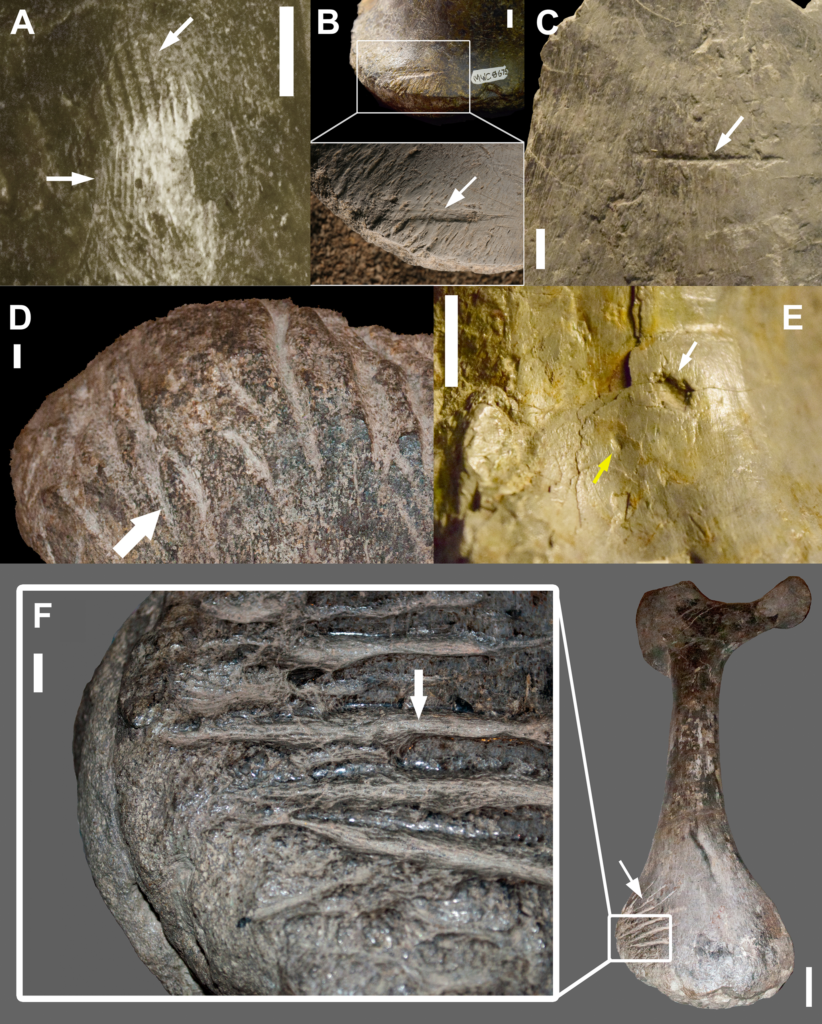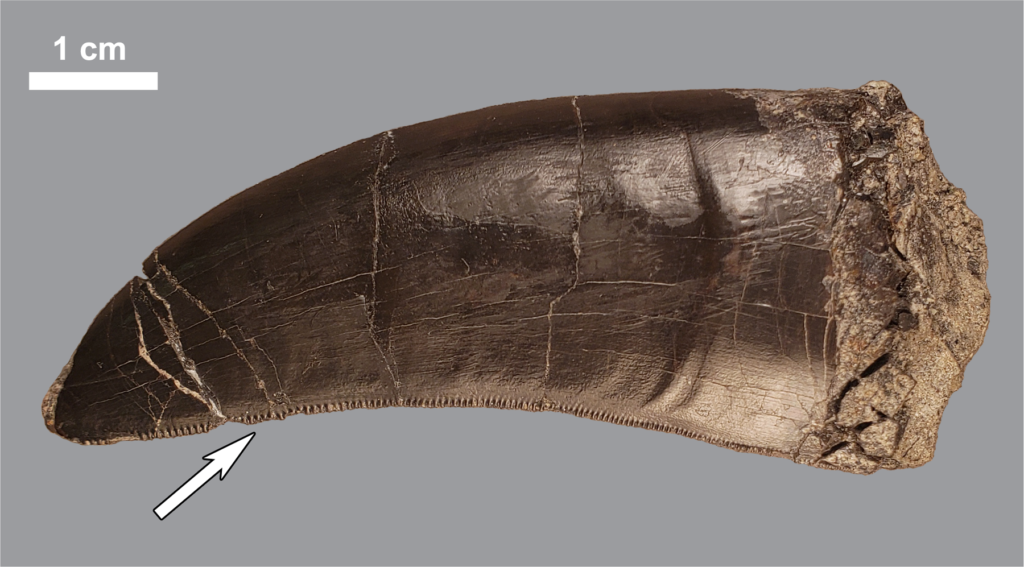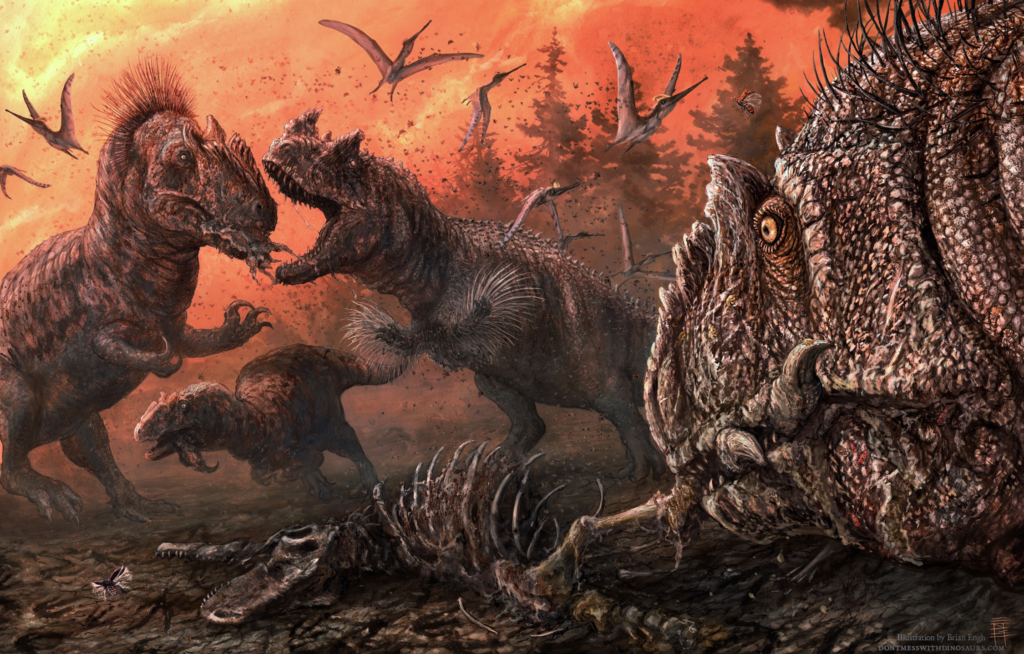@WFS,World Fossil Society,Riffin T Sajeev,Russel T Sajeev

Types of bite marks observed in the MMQ assemblage with arrows indicating features of note.
A, striated marks produced by ziphodont tooth on an Allosaurus sp. pedal claw (MWC 7263); B, a striated score on an Allosaurus sp. vertebral centrum (MWC 8675); C, a score on an Apatosaurus sp. rib fragment (MWC 3853); D, a dense cluster of furrows on a distal Apatosaurus sp. pubis (MWC 861); E, a puncture (white arrow) and a pit (yellow arrow) on an Allosaurus sp. caudal vertebral centrum; F, a dense cluster of striated furrows Apatosaurus sp. ischium (MWC 4011). All scale bars equal 10 mm.
Bite marks provide direct evidence for trophic interactions and competition in the fossil record. However, variations in paleoecological dynamics, such as trophic relationships, feeding behavior, and food availability, govern the frequency of these traces. Theropod bite marks are particularly rare, suggesting that members of this clade might not often focus on bone as a resource, instead preferentially targeting softer tissues. Here, we present an unusually large sample of theropod bite marks from the Upper Jurassic Mygatt-Moore Quarry (MMQ). We surveyed 2,368 vertebrate fossils from MMQ in this analysis, with 684 specimens (28.885% of the sample) preserving at least one theropod bite mark. This is substantially higher than in other dinosaur-dominated assemblages, including contemporaneous localities from the Morrison Formation. Observed bite marks include punctures, scores, furrows, pits, and striations. Striated marks are particularly useful, diagnostic traces generated by the denticles of ziphodont teeth, because the spacing of these features can be used to provide minimum estimates of trace maker size. In the MMQ assemblage, most of the striations are consistent with denticles of the two largest predators known from the site: Allosaurus and Ceratosaurus. One of the bite marks suggests that a substantially larger theropod was possibly present at the site and are consistent with large theropods known from other Morrison Formation assemblages (either an unusually large Allosaurus or a separate, large-bodied taxon such as Saurophaganax or Torvosaurus). The distribution of the bite marks on skeletal elements, particularly those found on other theropods, suggest that they potentially preserve evidence of scavenging, rather than active predation. Given the relative abundances of the MMQ carnivores, partnered with the size-estimates based on the striated bite marks, the feeding trace assemblage likely preserves the first evidence of cannibalism in Allosaurus.

Shed lateral tooth of Allosaurus sp. (MWC 5011) found at the Mygatt-Moore Quarry, white arrow indicates the distal denticles.Mesial denticles are present on such teeth, but were not preserved in this specimen.

Dry season at the Mygatt-Moore Quarry showing Ceratosaurus and Allosaurus fighting over the desiccated carcass of another theropod.Illustration by Brian Engh (dontmesswithdinosaurs.com).
Citation: Drumheller SK, McHugh JB, Kane M, Riedel A, D’Amore DC (2020) High frequencies of theropod bite marks provide evidence for feeding, scavenging, and possible cannibalism in a stressed Late Jurassic ecosystem. PLoS ONE 15(5): e0233115. https://doi.org/10.1371/journal.pone.0233115
Editor: David M. Lovelace, University of Wisconsin Madison, UNITED STATES
@WFS,World Fossil Society,Riffin T Sajeev,Russel T Sajeev



 June 14th, 2020
June 14th, 2020  Riffin
Riffin  Posted in
Posted in  Tags:
Tags: 